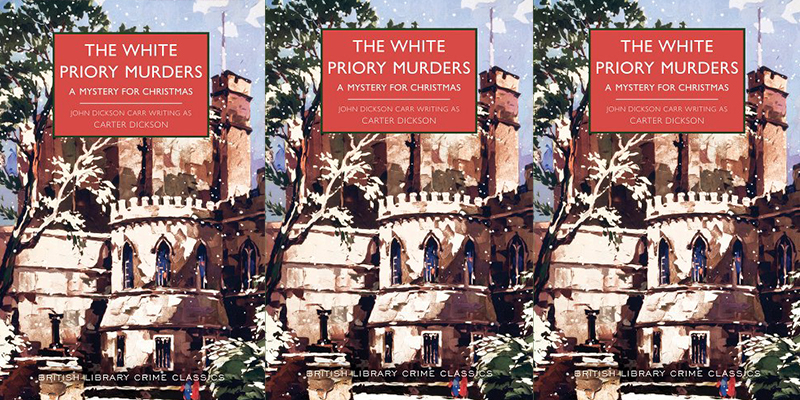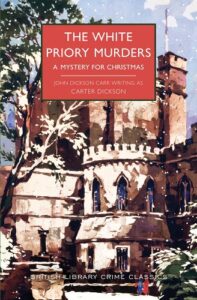The White Priory Murders is an “impossible crime” novel by the master of the locked-room mystery, John Dickson Carr, masquerading as Carter Dickson, the name associated with his stories featuring Sir Henry Merrivale. Originally published in 1934, this was Merrivale’s second recorded case, written with youthful verve at a time when the author was still in his twenties.
This is a mystery set in the run-up to Christmas, and the presence of snow on the ground provides the scenario for the paradox at the heart of the book. How could someone be beaten to death in the Queen’s Mirror pavilion, when it is surrounded by snow, and there is just one set of footprints leading to the pavilion, and none leading away?
The first edition of the novel listed the key characters on the flap of the dust jacket:
“Marcia Tait, glamorous film star, who has broken her Hollywood contract to open in a London play, The Private Life of Charles II;
The eccentric Maurice Bohun, author of the play, and Master of the White Priory;
John Bohun, his brother, in love with Marcia Tait;
Emery (publicity) and Rainger (production), who have rushed after Marcia Tait from Hollywood, trying to persuade her to return;
Mouthy old Lord Canifest, backer of the play, and his subdued daughter, Louise;
The lovely niece of the Bohuns, Katharine Bohun; Young James Bennett, American, nephew of Sir Henry Merrivale; and Chief Inspector Masters.
Two of these people are murdered. And one of them is the murderer.”
This is, therefore, not only an impossible crime story, but a “closed circle” mystery in the “fair play” tradition, in which the culprit is a member of a tightly defined group. The device of revealing that group in a “cast list” at the start of a detective novel was later developed into something of a fine art by Carr’s friend and fellow Detection Club member Christianna Brand.
In an admiring review in the Sunday Times, Dorothy L. Sayers praised the way the author kept “the equilibrium between his plot and his writing,” adding: “Mr. Dickson has handled this classic material very capably, using scrupulous fairness in deduction and concealing the identity of his criminal with considerable cunning. His group of characters contains a number of oddities, but the oddities are both interesting and believable, and he uses his skill in suggesting queerness, both of psychology and atmosphere, for the legitimate double purpose of distracting attention from the material clues and preparing our minds to accept his solution.’
Sir Henry Merrivale, often called “H.M.” or “the old man,” had made his debut in a locked-room-mystery novel published earlier in 1934, The Plague Court Murders. When writing that book, Carr envisaged the official police detective Masters would take centre stage. Merrivale only enters the story half-way through. The novel was published under a pseudonym partly (in effect) as a matter of branding, so as to differentiate it from his stories about Henri Bencolin and Dr Gideon Fell; he’d already published a non-series mystery, The Bowstring Murders, under the even more transparent pen-name, Carr Dickson.
Merrivale is a larger than life individual, with a personality so vivid that Carr soon realised that he, rather than the Scotland Yard man, should take centre stage in the books. Ultimately, Sir Henry appeared in twenty-two novels and two short stories, including “The House in Goblin Wood,” one of the finest of all detective puzzles in the short form.
Carr (1906–77) published his last Merrivale novel, The Cavalier’s Cup, in 1953, but the appeal of the character was such that for many years readers begged his creator to revive him. Among these fans was Francis Wilford Smith, who began to correspond with Carr after trying to put together a comprehensive chronology of Merrivale’s adventures. He calculated, for instance, that the events recorded in The White Priory Murders take place in December 1931.
Sir Henry Merrivale was a baronet and a man of varied accomplishments. A qualified physician, he was also a barrister, as we see to dramatic effect in The Judas Window (1938), widely acknowledged as one of the finest locked-room mysteries ever written. Initially characterized as “a fighting socialist,” he eventually shifts his political affiliations to fall in line with Carr’s conservative worldview. During the First World War he served as head of the British counter-espionage operations (earning the nickname “Mycroft”), and he continued to hold this post in the post-war era. Secret service work plays a part in three of his recorded adventures, The Unicorn Murders (1935), The Punch and Judy Murders (1936), and And So To Murder (1940), but his greatest gift is for detecting ingenious crimes and unravelling the puzzles which arise from what he calls “the blinkin’ awful cussedness of things in general.”
Carr took a great deal of care when constructing his intricate plots, but like most crime writers responsible for a long series, he proved fallible on matters of detail about his protagonist. He admitted in a letter to Smith that: “Errors or contradictions…abound in H.M.’s saga… During the nineteen-thirties, being young and full of beans, I was grinding out four novels a year.” As for bringing Merrivale back to life, he said: “Many readers seem fond of…the old gentleman… I also am fond of him. But that’s just the trouble. For many years certain critics…have been bewailing my ‘schoolboy’ sense of humour. H.M. usually enters the story with a rush and a crash, heels in the air. Once, in an unwise moment, I gave the date of his birth: February 6th, 1871. If he were alive today he would be ninety-six years old. His customary antics at so venerable an age would be as inadvisable for him to perform as for me to chronicle.”
Carr flirted with the idea of setting a new story “back to a time when he [Merrivale] was a mere stripling… In that case…even so deplorable a sense of humour might be pardoned for one or two books more.” In discussion with his literary agents, he contemplated titles such as Commander Sir Henry Merrivale, Enter Three Poisoners, and The Nine Black Reasons. Ultimately, he decided against writing more stories about the old man. Nevertheless, the Merrivale canon includes some outstanding examples of the impossible crime scenario, and The White Priory Murders is an entertaining illustration of Carr’s skill as a literary conjuror.
______________________


















